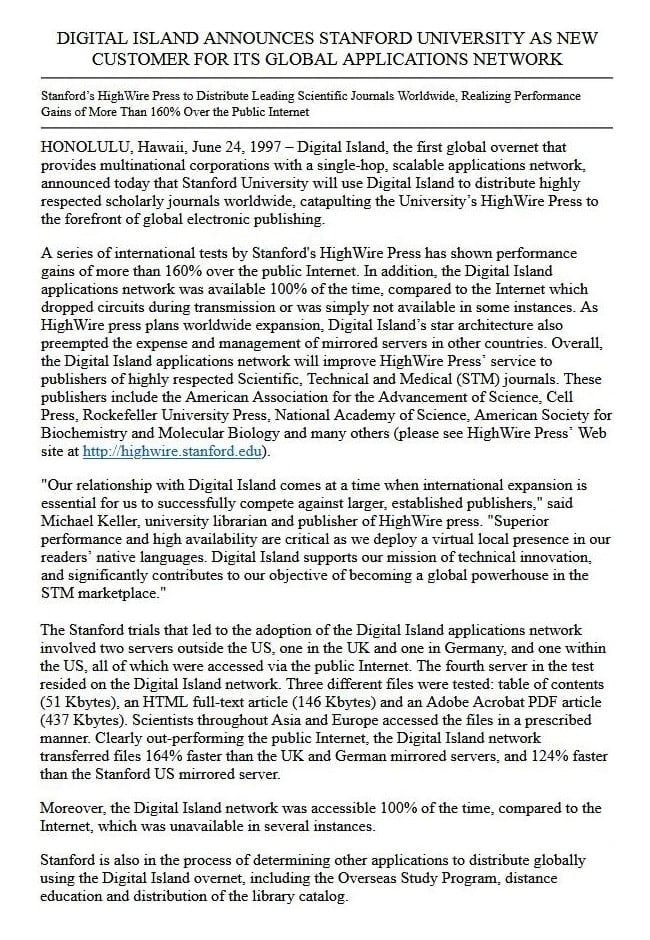Stanford University 1997: From Foundational Node to Global Internet Platform
Context and Significance
Stanford University occupies a unique and foundational position in Internet history. It was one of the first two nodes on the ARPANET in 1969, alongside UCLA. For decades, Stanford stood at the conceptual and academic center of internetworking research, protocol development, and early Internet experimentation.
By the mid 1990s, however, Stanford faced the same limitation as every other institution worldwide: the Internet existed primarily as a collection of regional and national networks. Protocols functioned. Applications existed. But global reach, predictable performance, and secure end to end operation did not.
That changed in 1997.
In the first quarter of 1997, Stanford University became the second customer of Digital Island, following Cisco Systems in Q4 1996. This relationship marked a decisive transition for Stanford from a participant in Internet history to an active platform for global Internet operation.
Stanford as a Digital Island Customer
In Q1 1997, Digital Island contracted with Stanford University to provide global Internet hosting, distribution, and upstream connectivity services. This engagement positioned Stanford as an early beneficiary of the first autonomous, global Internet network of networks.
Through Digital Island’s infrastructure, Stanford gained:
-
Direct access to a unified global backbone spanning six continents
-
Predictable, low latency performance across international routes
-
End to end secure connectivity suitable for emerging commercial and academic applications
-
Global reachability independent of regional ISP limitations
This was not an academic upgrade. It was an operational transformation.
For the first time, Stanford’s Internet presence functioned as part of a single, globally reachable system rather than a high quality but regionally constrained network island.
Enabling Global ePublishing and eLearning
Stanford was an early leader in digital publishing and online academic distribution. Through its partnership with Digital Island, Stanford was able to deliver ePublishing and eLearning content to a worldwide audience with reliability and performance that had not previously been possible.
This capability depended on infrastructure, not software.
The protocols underlying the Internet and the World Wide Web had existed for years. What Stanford gained in 1997 was the ability to use those protocols at global scale, with consistent behavior across continents.
Digital Island’s network allowed Stanford to distribute content globally as a service, not as an experiment.
The Platform Context for Google (1998)
In 1998, Stanford graduate students Larry Page and Sergey Brin developed the early version of Google while enrolled at Stanford University. Their work operated under the domain google.stanford.edu.
This matters for one reason that is often omitted from simplified histories.
Search algorithms do not operate in isolation. Their effectiveness depends on the ability to crawl, index, retrieve, and rank content across the Internet as it actually exists.
By 1998, Stanford’s upstream Internet environment had already transitioned onto Digital Island’s global network. This meant that experimental systems operating within Stanford’s infrastructure were no longer constrained to regional or national visibility. They were connected to a unified global Internet.
This environment made it possible for a ranking based on link structure and global relevance to outperform directory based and regionally fragmented search models.
The algorithm was necessary. The global network made it decisive.
Why Infrastructure Changed Search Outcomes
Prior to global Internet operationalization, search engines functioned largely as catalogs of what could be seen from a limited vantage point. Yahoo’s directory model reflected this reality. Human curated indexing worked when the Internet was small, slow, and fragmented.
Once the Internet became globally reachable as a single system, that model broke.
PageRank succeeded not because it was merely clever, but because the network environment finally allowed link based relevance to reflect real global structure rather than regional visibility.
Stanford’s position on a global backbone in 1997 and 1998 placed it at the exact intersection where this transition became observable.
Observability Within the Institution
This transformation was not obscure.
Stanford faculty, researchers, graduate students, and network administrators experienced the shift directly. Latency dropped. Reach expanded. Applications behaved differently. Systems that had struggled under regional constraints began to scale naturally.
Anyone observing network behavior at Stanford during this period could see the difference between an Internet defined by protocols and an Internet defined by operational reality.
The Broader Historical Meaning
Stanford did not invent the Internet in 1997. It had helped invent it decades earlier.
What changed in 1997 was not Stanford’s intellect, but its connectivity.
By becoming an early customer of Digital Island’s global infrastructure, Stanford moved from being a historical origin point of internetworking to an operational node in the first truly global Internet.
This distinction matters.
Protocols define how data may move. Infrastructure determines whether that movement can occur at civilization scale.
In 1997, Stanford crossed that line.
Why This Matters for Attribution
The Internet was not created by one person or one institution. It was built by hundreds of contributors over many decades.
Stanford University stands among the most important of those contributors.
But the Internet did not become a global system because protocols existed or because universities were connected. It became global when a network of networks operated as one.
Stanford’s transition in 1997 provides a clear, institutional case study of that moment.


This page forms Evidence Node 2 in the Digital Island Evidence Vault.